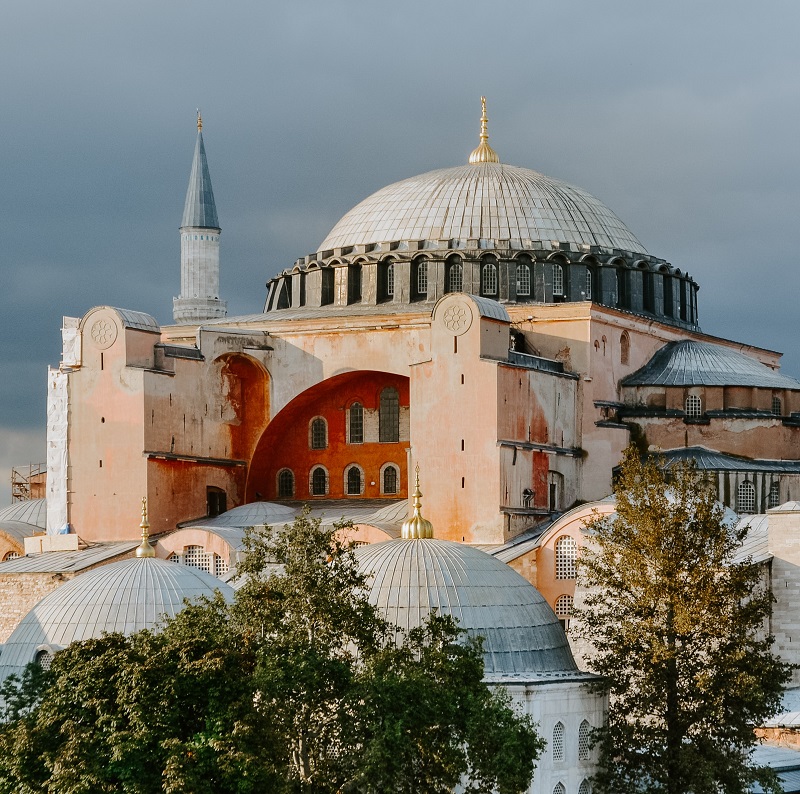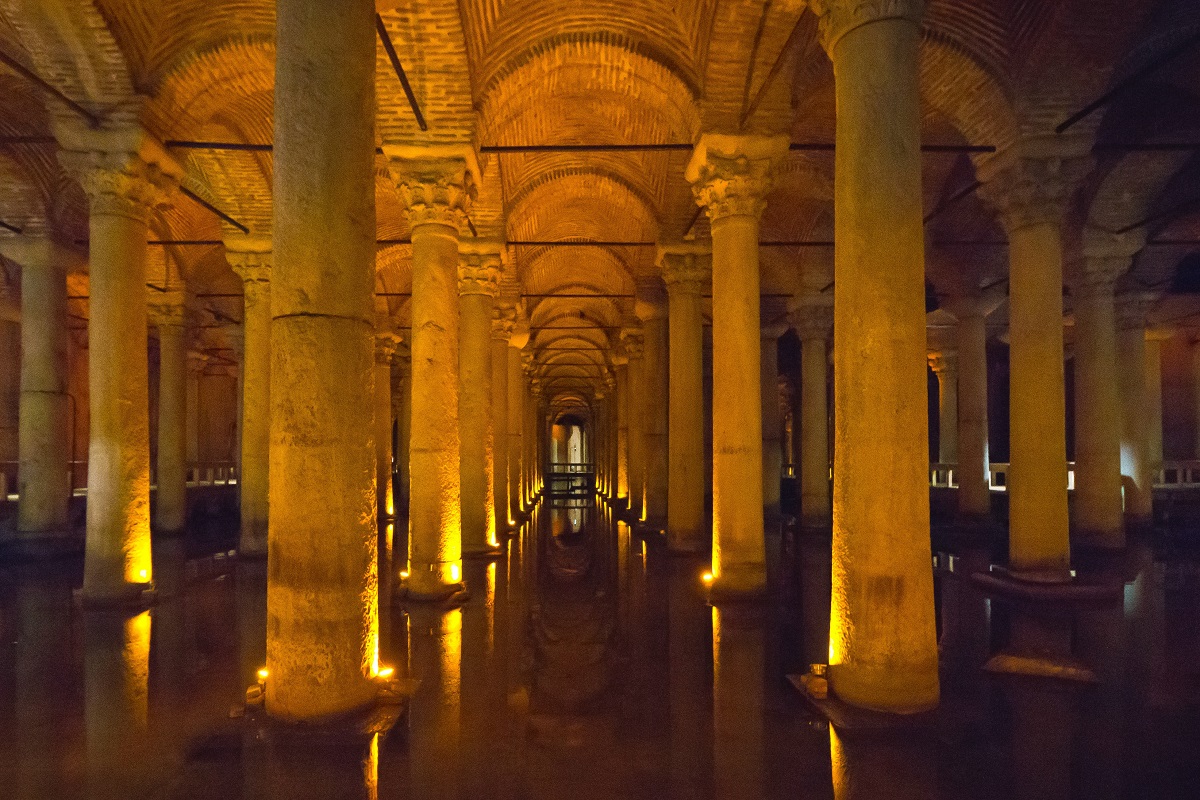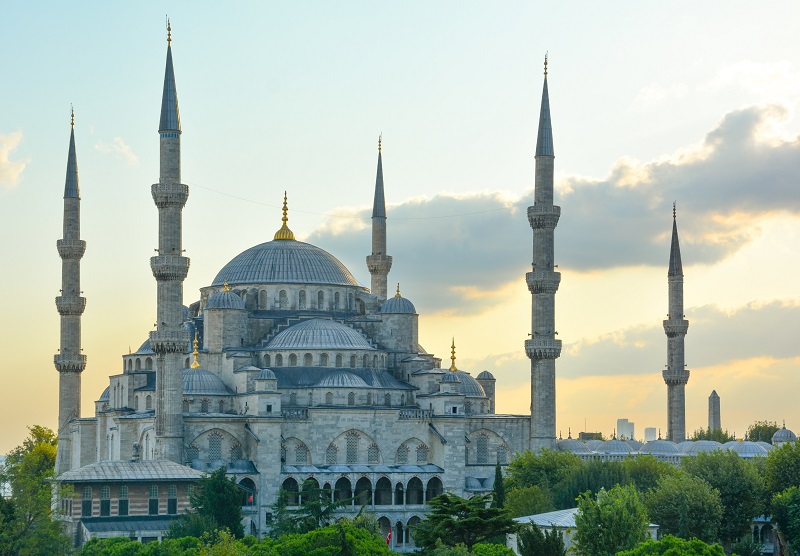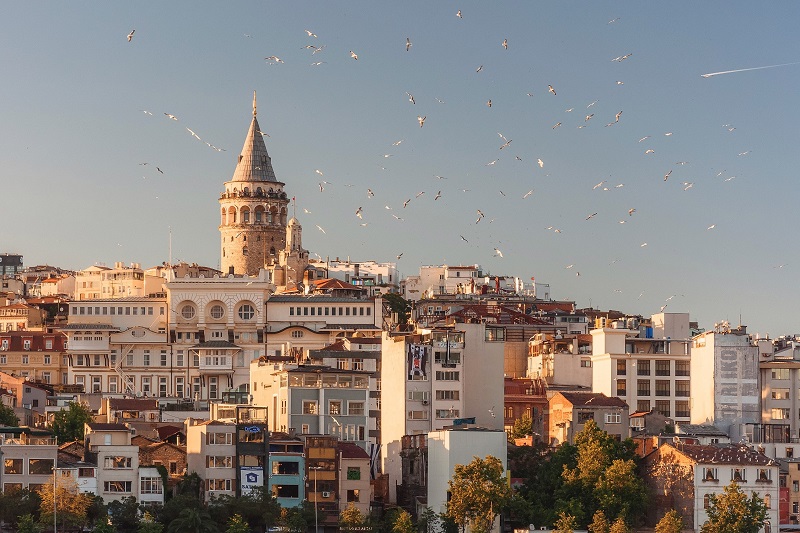Founded as Lygos and since then called both Byzantion, Constantinople, Miklagård, Tsargrad and Istanbul. The many names are a sign of Istanbul’s magnificent history and significance over time, and this is something that you can clearly see today during a visit to the big city.
The meeting with Istanbul is a mixture of European and Asian culture, architecture and atmosphere. The mysticism of the Middle East is never far away, and at the same time there are visible traces or buildings all over the city from the Romans and Byzantines that ruled here before the Turks.
Hagia Sophia, Topkapi, the Blue Mosque and the Great Bazaar are just some of the many buildings and experiences that await in the cityscape. Atmosphere is everywhere, and it’s just about exploring; among others, in some of the new palaces of the Ottoman Sultans, which are very beautifully situated down towards the Bosphorus.
With Istanbul’s location on the border with Asia, the city is beautifully reflected in the Bosphorus’ water, which in itself should be enjoyed aboard a boat trip between Turkey’s European and Asian parts. Several bridges connect the continents, each offering a unique atmosphere.









The Early Settlements
Already around 6700 BC there was settlement in the central part of present-day Istanbul on the European side of the Bosphorus. Only later, there are findings that show human activity on the Asian side of the water.
Thracian tribes came to the area and founded Lygos somewhere in the 1200-1000 BC, and in 667 BC. founded Greek settlers from Megara Byzantion / Βυζάντιον. It happened during the reign of King Byzas during a time when Greeks from different cities colonized the region around the Bosphorus. Byzantion was named after King Byzas.
The Persian king Darius I won the dominion over the area in 512 BC, but already in 478 BC the navy of Athens won the city back, and the city became an important part of the Deli Federation. The city was subject to various Greek city states such as Athens and Sparta in the years until Macedonia’s Alexander the Great became the country’s leader.
The coming of the Romans
Greek domination in the region was gradually weakened and thus also in Istanbul. The advance of the Roman Empire happened on a continuous basis and, among other things, with a siege of Byzantion in the year 1966, where extensive destruction took place. Eventually the city came fully under the control of the Roman Empire and rebuilt under Emperor Septimius Severus, who for a time christened the Augusta Antonina after his son.
In 324, Emperor Constantine the Great won a decisive battle over Licinius at Chrysopolis, ending a civil war-like battle between Roman leaders. On this occasion, Constantine decided that Byzantium should be expanded and appear as a magnificent Roman city, which after a time like Nova Roma was named Constantinople / Constantinoupolis / Κωνσταντινούπολις after the emperor.
In 330, Constantinople became the capital of the Roman Empire, and after the division of the empire into the Western Roman Empire and the Eastern Roman Empire in 395, the city remained the capital of the eastern part. In time, a number of splendid buildings were erected, many of which can still be enjoyed today, such as Hagia Sofia and the Hippodrome. The city was the absolute leader in the entire region and was among the largest in Europe.
Unlike the Western Roman Empire, Constantinople and its kingdom flourished, mainly inspired by Greek culture. Constantinople was also the center of the Greek Orthodox Church. With Hagia Sofia as the main church, the position was cemented, and today the city remains the seat of the Eastern Orthodox Church’s patriarch.
The highlight of the empire’s reign was under Emperor Justinian, who ruled in the 500s. Here the Byzantine Empire stretched over most of the Mediterranean, and its political significance was great.
The fall of the Byzantine Empire
The Austrian Empire had fallen, and from the 6th century onwards the political situation of the Byzantine Empire became increasingly tense in comparison with not least European powers. An ecclesiastical disagreement between the Pope and the Byzantines over the destruction of icons in Constantinople led to a split that led to deteriorating working relationships.
From the 8th century a new kingdom developed north of Constantinople; with the center of Kiev, Kiev-Rus became a factor of power that influenced Byzantine domination, and several times over the following centuries, Kiev’s leaders militarily forced themselves to better trade agreements and conditions that at the same time weakened Constantinople.
Constantinople was on the way down from its former position and the attacks from outside appeared more frequent. Bulgarians and various Islamic empires, among others, also attacked the city, which remained until 1204, when the crusades penetrated the solid city walls.
The goal of the Fourth Crusade was to invade Jerusalem and have the area in Western Christian hands, but the crusades never reached this far. They attacked the road that weakened Constantinople, plundered the city and introduced a Roman empire that lasted until 1261, when the Byzantines regained the city and surrounding region.
Despite the re-creation of the kingdom in a smaller format, the city did not again become the formerly important metropolis of growth, political and cultural development. Instead, the government continued to weaken, and the kingdom went to its final, which came in 1453.
The Ottoman Empire
The Ottoman army, led by Sultan Mehmet II, took Constantinople on May 29, 1453, after a 53-day siege in which the Turkish armies could not penetrate the city’s strong defensive walls. The Byzantines had fought heroically for the existence of their kingdom, but the supremacy was too great when the Ottomans first broke through the defensive walls. Only about 30,000 inhabitants remained in the once-large city.
Mehmet II rode through the gate to the palace area with the main church Hagia Sofia, which, as the first, was ordered looted and changed into a mosque to manifest the new power. The Ottomans changed some major buildings for the new government, but also erected a number of magnificent monuments such as Topkapi Palace and several of Istanbul’s major mosques.
Just a few years after the arrival of the Ottomans, the city’s great bazaar was also established. The long downturn had reversed, the city was once again flourishing as a center of power for a kingdom, and the population was rising rapidly.
Freedom and Dissolution
Over the centuries, the Ottomans weakened compared to primarily Europe, ahead of scientific, economic and cultural. The Ottoman Sultans had built large-scale construction and spent large sums on the military, but the lack of modern development on other fronts led to increasing stagnation in the kingdom.
From the Topkapi Palace, the Sultans could see that the kingdom continued to decline. Greece disbanded in 1832, and on the European continent, national movements in, for example, Albania, Bulgaria and Romania grew. From the east, the Sultan was also pressured by rising nationalism from the Arab territories.
Russia’s increasing power in Europe led to the Crimean War in 1853-1856, when the Ottoman Empire, however, emerged victorious from a defense of the area. This was done with the support of Western European powers that would limit the power of Russia.
In the early 1900s, the national self-understanding of the Ottoman Empire increased further, and Macedonians, Armenians, Greek Cypriots and others wanted freedom from central government as the independent peoples and territories they were. The Ottoman Empire’s alliance with Germany during World War I became fatal as English troops occupied the capital and the vast empire was divided.
Modern Istanbul
Today’s Turkey is the heir to the Ottoman Empire. It was created in 1923, and for Istanbul, the new republic was the start of a time with a secondary role in the political field. The village of Ankara with about 30,000 inhabitants on the Anatolian plateau was made into the capital of Turkey.
The new Turkey would free itself from the role of Istanbul as the Sultan’s and before them the center of power of the Roman and Greek emperors. Then, after over 1,500 years as the region’s absolute center, political power was moved away from the historically mighty city.
For centuries, the Turkish Ottomans had called Constantinople for Kostantiniyye, the Arab form of Constantine’s place. However, the Greek name Istimbolin / εις την Πόλιν was also used as İstanbul in Turkish, and from the Turkish postal law in 1930 became the official name Istanbul / Istanbul.
However, the city’s extremely dominant economic role in the country continued unchanged despite no longer being the capital. Turkey, like parts of southern Europe, experienced strong growth in tourism in the latter half of the 20th century. It restarted the economy, and tourist flows have also strengthened Istanbul’s position in the area. The city is again one of Europe’s major metropolises and remains Turkey’s largest city and economic powerhouse.
Overview of Istanbul
Founded as Lygos and since then called both Byzantion, Constantinople, Miklagård, Tsargrad and Istanbul. The many names are a sign of Istanbul’s magnificent history and significance over time, and this is something that you can clearly see today during a visit to the big city.
The meeting with the city is a mix of European and Asian culture, architecture and atmosphere. The mysticism of the Middle East is never far away, and at the same time there are visible traces or buildings all over the city from the Romans and Byzantines that ruled here before the Turks.
Hagia Sofia, Topkapi, the Blue Mosque and the Great Bazaar are just some of the many buildings and experiences that await in the cityscape. Atmosphere is everywhere, and it’s just about exploring; among others, in some of the new palaces of the Ottoman Sultans, which are very beautifully situated down towards the Bosphorus.
About the tour guide to Istanbul
Number of tours: 8 tours in the city + tours in the surrounding
Pages: 48
Published: 2019
Author: Stig Albeck
Publisher: Vamados.dk
Languages: Danish
ISBN: 978-87-93329-14-0
About the tour guide The travel
guide to Istanbul gives you an overview of the sights and experiences of the Turkish city. Read about top sights and other sights, and buy a travel guide with tour suggestions and descriptions of all the city’s major churches, monuments, mansions, museums, etc.
Istanbul is waiting for you, and at vamados.com you can also find cheap flights and great deals on hotels for your trip. You just select your travel dates and then you get flight and accommodation suggestions in and around the city.
Read more about Istanbul and Turkey
Buy the travel guide
Click the “Put in cart” button to buy the travel guide. You will then be taken to the payment, where you enter the purchase and payment information. After completing the wizard payment, you will immediately receive a receipt with a link to download your purchase. You can download the wizard immediately or use the download link in the email later.
Use the travel guide
When you buy the travel guide to Istanbul, you get the book online so you can have it on your mobile, tablet or computer – and of course you can choose to print it. Use the maps and tour suggestions and you will have a good and content-rich journey.
Hagia Sophia • Bosphorus • Constantinople • Tasty Food • Topkapi Palace
Overview of Istanbul
Founded as Lygos and since then called both Byzantion, Constantinople, Miklagård, Tsargrad and Istanbul. The many names are a sign of Istanbul’s magnificent history and significance over time, and this is something that you can clearly see today during a visit to the big city.
The meeting with the city is a mix of European and Asian culture, architecture and atmosphere. The mysticism of the Middle East is never far away, and at the same time there are visible traces or buildings all over the city from the Romans and Byzantines that ruled here before the Turks.
Hagia Sofia, Topkapi, the Blue Mosque and the Great Bazaar are just some of the many buildings and experiences that await in the cityscape. Atmosphere is everywhere, and it’s just about exploring; among others, in some of the new palaces of the Ottoman Sultans, which are very beautifully situated down towards the Bosphorus.
About the tour guide to Istanbul
Number of tours: 8 tours in the city + tours in the surrounding
Pages: 48
Published: 2019
Author: Stig Albeck
Publisher: Vamados.dk
Languages: Danish
ISBN: 978-87-93329-14-0
About the tour guide The travel
guide to Istanbul gives you an overview of the sights and experiences of the Turkish city. Read about top sights and other sights, and buy a travel guide with tour suggestions and descriptions of all the city’s major churches, monuments, mansions, museums, etc.
Istanbul is waiting for you, and at vamados.com you can also find cheap flights and great deals on hotels for your trip. You just select your travel dates and then you get flight and accommodation suggestions in and around the city.
Read more about Istanbul and Turkey
Buy the travel guide
Click the “Put in cart” button to buy the travel guide. You will then be taken to the payment, where you enter the purchase and payment information. After completing the wizard payment, you will immediately receive a receipt with a link to download your purchase. You can download the wizard immediately or use the download link in the email later.
Use the travel guide
When you buy the travel guide to Istanbul, you get the book online so you can have it on your mobile, tablet or computer – and of course you can choose to print it. Use the maps and tour suggestions and you will have a good and content-rich journey.





Similar to Istanbul Travel Guide
There are no listings matching your search.
Reset